fuse box FORD TRANSIT 2006 7.G Body And Equipment Mounting Section Manual
[x] Cancel search | Manufacturer: FORD, Model Year: 2006, Model line: TRANSIT, Model: FORD TRANSIT 2006 7.GPages: 234, PDF Size: 33.19 MB
Page 129 of 234

Battery Disconnect Switch
Battery Disconnect Switch Relay Parameters
260 ampsNormally open contacts
3.3 A @ 25°CNominal coil current
High Power Bistable relay - Part number: 6C1T-10B728-A_
In addition to the fuses and relays fitted to the
Pre Fuse Box (PFB), Engine Junction Box (EJB)
and Central Junction Box (CJB), depending on
vehicle options, there may be up to 3 relays
mounted directly to the Heating, Ventilation and
Air-conditioning (HVAC) unit. These relays should
not be tampered with as they affect operation
of the associated system.
Heating, Ventilation and Air-conditioning (HVAC)
1 x 82GG-13A025-CAAir-conditioning
2 x 82GG-13A025-CAFuel-fired Heater without Air-conditioning
3 x 82GG-13A025-CAFuel-fired Heater with Air-conditioning*
*In addition to the relays, there is a diode 91AG-10374-B_
These relays have a different terminal
arrangement to those fitted throughout the rest
of the vehicle – if they need to be replaced, only
components with the same Ford part number
should be used.
Switches and their Illumination
The main instrument panel switches work in
conjunction with the Central Junction Box, and
are momentary action (non-latching) types. The
Central Junction Box is responsible for control
operation of the respective systems.
For any additional functions, unless the
interfacing module accommodates momentary
action switches, it is recommended that latching
types are used.
Three switches are available:
DescriptionFord Part Number
Rotary light (beacon)6C1V-13D768-A_
Rear work lamp6C1V-13D756-A_
Water faucet (heater)6C1V-19H218-A_
Search illumination for added switches can be
taken from any of the existing switches, by
connecting to the appropriate feed wire.
FordTransit 2006.5 (April 2006–)
Date of Publication: 12/2006
4 Electrical
129E750211234AB4312BA
Page 130 of 234
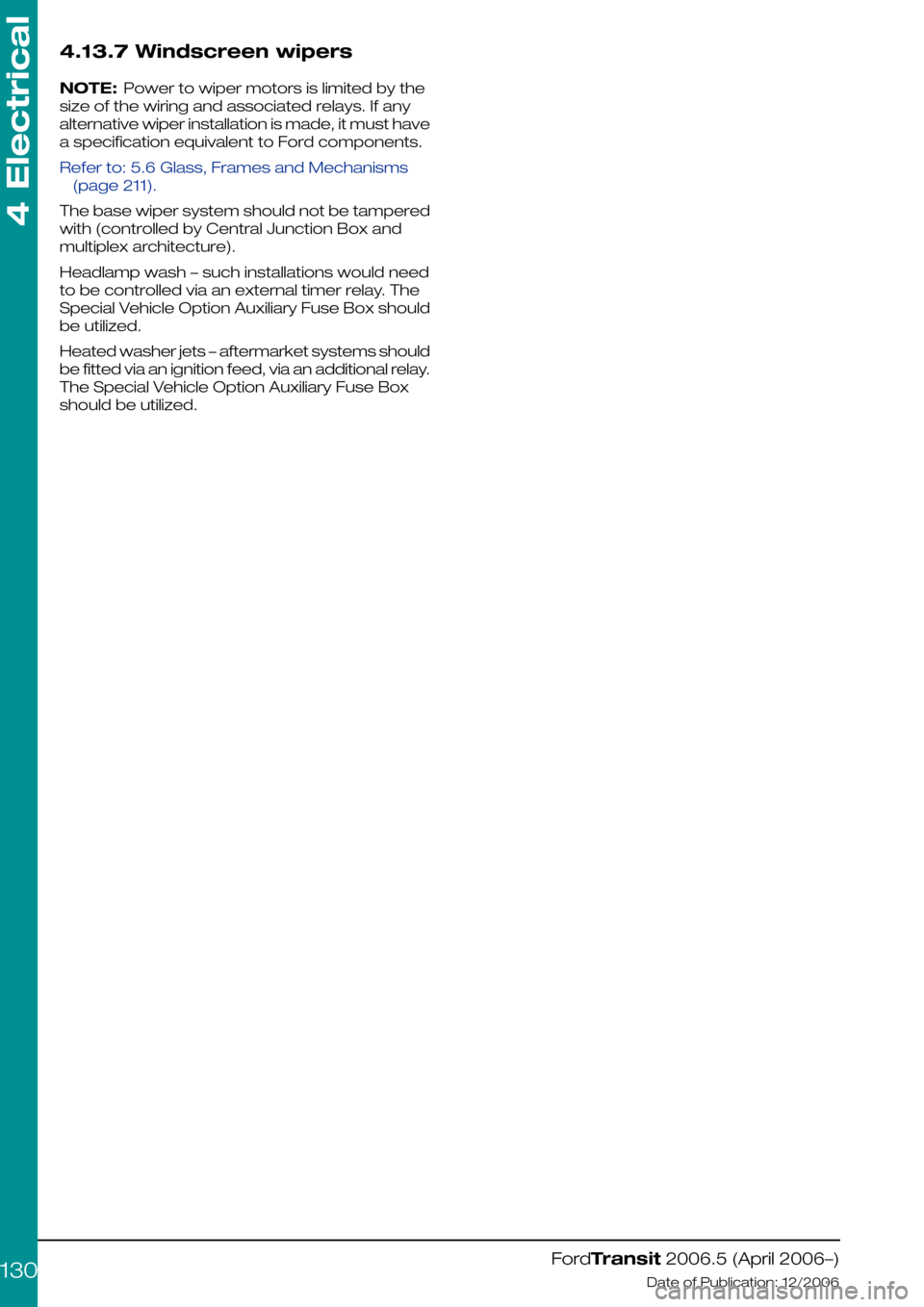
4.13.7 Windscreen wipers
NOTE: Power to wiper motors is limited by the
size of the wiring and associated relays. If any
alternative wiper installation is made, it must have
a specification equivalent to Ford components.
Refer to: 5.6 Glass, Frames and Mechanisms
(page 211).
The base wiper system should not be tampered
with (controlled by Central Junction Box and
multiplex architecture).
Headlamp wash – such installations would need
to be controlled via an external timer relay. The
Special Vehicle Option Auxiliary Fuse Box should
be utilized.
Heated washer jets – aftermarket systems should
be fitted via an ignition feed, via an additional relay.
The Special Vehicle Option Auxiliary Fuse Box
should be utilized.
FordTransit 2006.5 (April 2006–)
Date of Publication: 12/2006
4 Electrical
130
Page 133 of 234
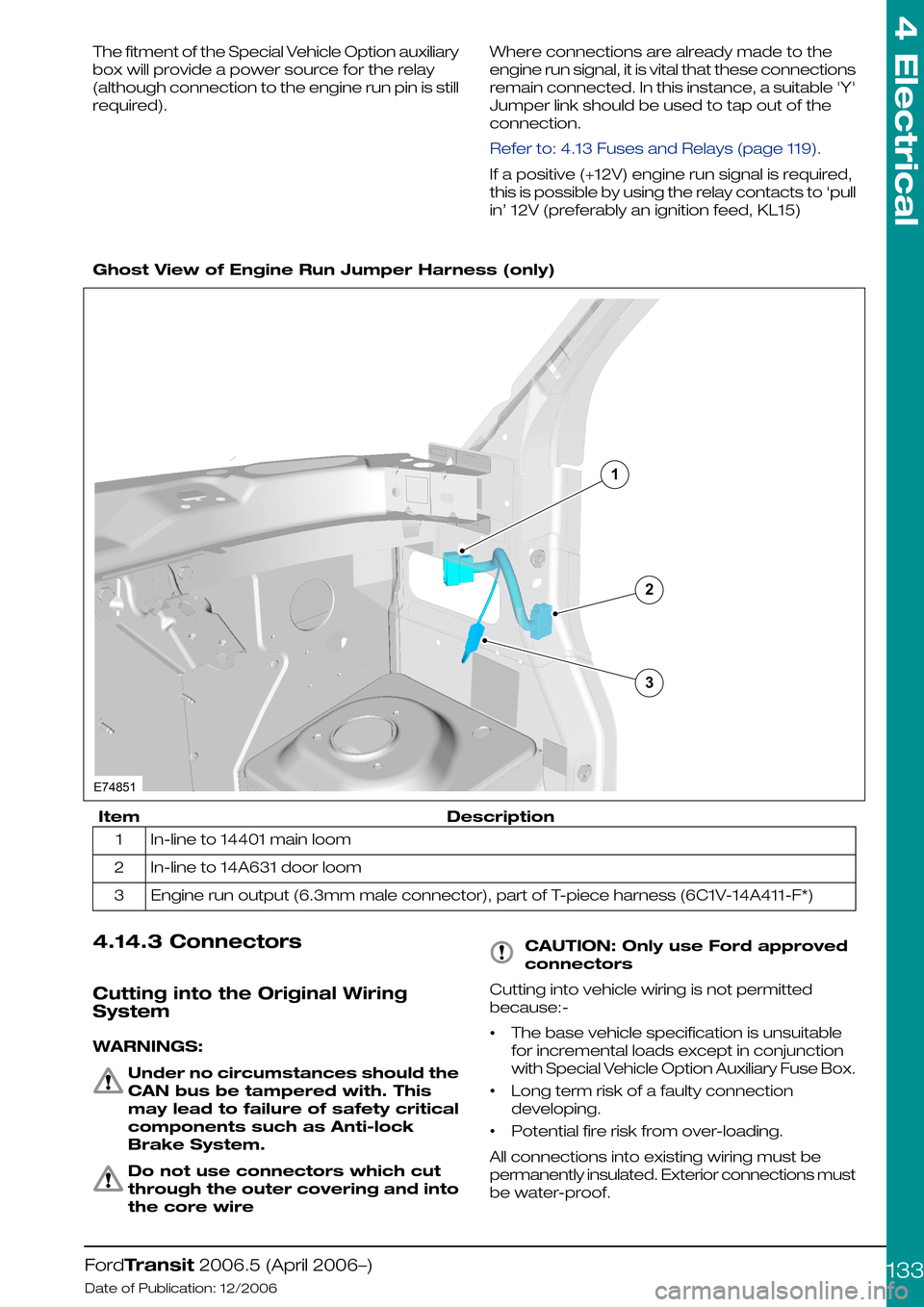
The fitment of the Special Vehicle Option auxiliary
box will provide a power source for the relay
(although connection to the engine run pin is still
required).
Where connections are already made to the
engine run signal, it is vital that these connections
remain connected. In this instance, a suitable 'Y'
Jumper link should be used to tap out of the
connection.
Refer to: 4.13 Fuses and Relays (page 119).
If a positive (+12V) engine run signal is required,
this is possible by using the relay contacts to ‘pull
in’ 12V (preferably an ignition feed, KL15)
Ghost View of Engine Run Jumper Harness (only)
DescriptionItem
In-line to 14401 main loom1
In-line to 14A631 door loom2
Engine run output (6.3mm male connector), part of T-piece harness (6C1V-14A411-F*)3
4.14.3 Connectors
Cutting into the Original Wiring
System
WARNINGS:
Under no circumstances should the
CAN bus be tampered with. This
may lead to failure of safety critical
components such as Anti-lock
Brake System.
Do not use connectors which cut
through the outer covering and into
the core wire
CAUTION: Only use Ford approved
connectors
Cutting into vehicle wiring is not permitted
because:-
•The base vehicle specification is unsuitable
for incremental loads except in conjunction
with Special Vehicle Option Auxiliary Fuse Box.
•Long term risk of a faulty connection
developing.
•Potential fire risk from over-loading.
All connections into existing wiring must be
permanently insulated. Exterior connections must
be water-proof.
FordTransit 2006.5 (April 2006–)
Date of Publication: 12/2006
4 Electrical
133132E74851
Page 146 of 234

4.14.7 Special Vehicle Options
(SVO) and Aftermarket Kits
In addition to the trailer tow kits and SVO fuse box
already mentioned, a number of other kits are
under development to meet customer needs
The following Special Vehicle harnesses and
aftermarket kits are available:
Special Vehicle Option (SVO) Harnesses
Front beacon6C1V-10A933-C_
Rear beacon6C1V-10A933-D_
Roof mounted, rear turn signal jumper (1 required; needs B_ parts also).
Van, Bus and Kombi only.
6C1V-13B472-A_
Roof mounted, rear turn signal jumper (2 required; needs A_ part also).
Van, Bus and Kombi only.
6C1V-13B472-B_
Trailer tow jumper for camper / Cab Van Floor (13 pin)6C1V-13B472-B_
Special Vehicle Option Fuse box6C1V-14517-D_
“Nugget” loom, illumination and ignition6C1V-14A411-H_
Engine run jumper (between 14401 and 14A631 in A-pillar)6C1V-14A411-F_
Long/medium series with manual locking lift-gate jumper6C1V-14405-A_
Long series with power locking lift-gate jumper6C1V-14405-B_
Med Cab Van Floor underfloor harness (with integrated trailer tow wiring)6C1V-14406-R_
Long Cab Van Floor underfloor harness (with integrated trailer tow wiring)6C1V-14406-S_
Camper / Cab Van Floor rear lamp extension jumper (chassis cab lamps),
2 required
6C1V-14408-A_
Beacon switch (from SVO fuse box connector C3)6C1V-14A303-D_
In-line harness to 2 x Customer Connection Points (always required with
SVO fuse box)
6C1V-14300-C_
3rd battery positive6C1V-14300-A_
3rd battery negative (ground)6C1V-14301-A_
Negative (ground) cable for camper, twin battery6C1V-14301-B_
Negative (ground) cable for camper, single battery6C1V-14301-C_
Aftermarket Kits
Trailer tow, 13-pin Van, Bus, KombiAM6C1J-15A416-A_
Trailer tow, 7-pin Van, Bus, KombiAM6C1J-15A416-B_
Trailer tow, 13-pin Chassis CabAM6C1J-15A416-C_
Trailer tow, 7-pin Chassis CabAM6C1J-15A416-D_
Trailer Tow, 12N & 12S Jumper Harness*
*Contact your local National Sales Company Representative
Refer to: 1.3 Contact Information (page 9).
FordTransit 2006.5 (April 2006–)
Date of Publication: 12/2006
4 Electrical
146
Page 154 of 234
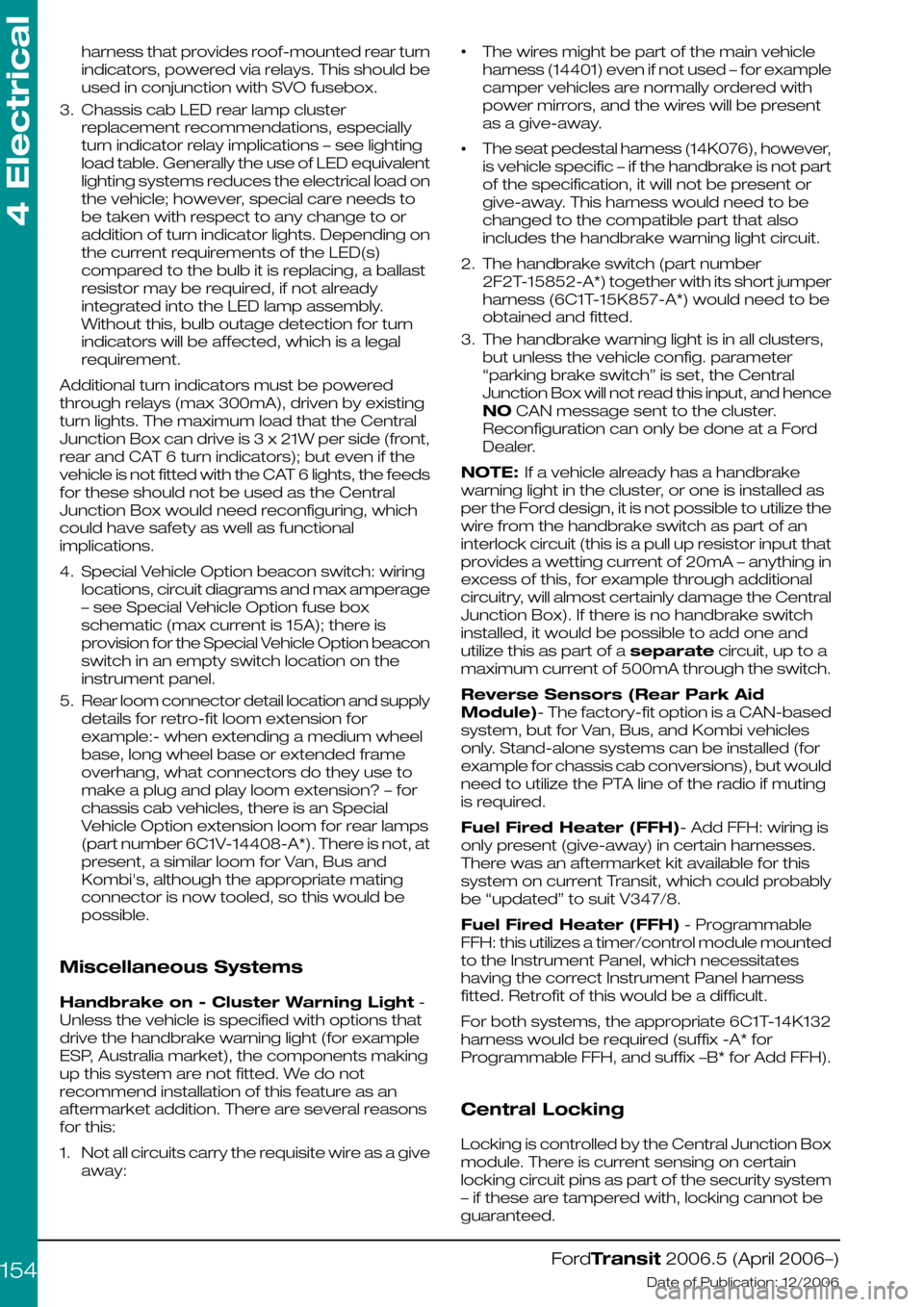
harness that provides roof-mounted rear turn
indicators, powered via relays. This should be
used in conjunction with SVO fusebox.
3.Chassis cab LED rear lamp cluster
replacement recommendations, especially
turn indicator relay implications – see lighting
load table. Generally the use of LED equivalent
lighting systems reduces the electrical load on
the vehicle; however, special care needs to
be taken with respect to any change to or
addition of turn indicator lights. Depending on
the current requirements of the LED(s)
compared to the bulb it is replacing, a ballast
resistor may be required, if not already
integrated into the LED lamp assembly.
Without this, bulb outage detection for turn
indicators will be affected, which is a legal
requirement.
Additional turn indicators must be powered
through relays (max 300mA), driven by existing
turn lights. The maximum load that the Central
Junction Box can drive is 3 x 21W per side (front,
rear and CAT 6 turn indicators); but even if the
vehicle is not fitted with the CAT 6 lights, the feeds
for these should not be used as the Central
Junction Box would need reconfiguring, which
could have safety as well as functional
implications.
4.Special Vehicle Option beacon switch: wiring
locations, circuit diagrams and max amperage
– see Special Vehicle Option fuse box
schematic (max current is 15A); there is
provision for the Special Vehicle Option beacon
switch in an empty switch location on the
instrument panel.
5.Rear loom connector detail location and supply
details for retro-fit loom extension for
example:- when extending a medium wheel
base, long wheel base or extended frame
overhang, what connectors do they use to
make a plug and play loom extension? – for
chassis cab vehicles, there is an Special
Vehicle Option extension loom for rear lamps
(part number 6C1V-14408-A*). There is not, at
present, a similar loom for Van, Bus and
Kombi's, although the appropriate mating
connector is now tooled, so this would be
possible.
Miscellaneous Systems
Handbrake on - Cluster Warning Light -
Unless the vehicle is specified with options that
drive the handbrake warning light (for example
ESP, Australia market), the components making
up this system are not fitted. We do not
recommend installation of this feature as an
aftermarket addition. There are several reasons
for this:
1.Not all circuits carry the requisite wire as a give
away:
•The wires might be part of the main vehicle
harness (14401) even if not used – for example
camper vehicles are normally ordered with
power mirrors, and the wires will be present
as a give-away.
•The seat pedestal harness (14K076), however,
is vehicle specific – if the handbrake is not part
of the specification, it will not be present or
give-away. This harness would need to be
changed to the compatible part that also
includes the handbrake warning light circuit.
2.The handbrake switch (part number
2F2T-15852-A*) together with its short jumper
harness (6C1T-15K857-A*) would need to be
obtained and fitted.
3.The handbrake warning light is in all clusters,
but unless the vehicle config. parameter
“parking brake switch” is set, the Central
Junction Box will not read this input, and hence
NO CAN message sent to the cluster.
Reconfiguration can only be done at a Ford
Dealer.
NOTE: If a vehicle already has a handbrake
warning light in the cluster, or one is installed as
per the Ford design, it is not possible to utilize the
wire from the handbrake switch as part of an
interlock circuit (this is a pull up resistor input that
provides a wetting current of 20mA – anything in
excess of this, for example through additional
circuitry, will almost certainly damage the Central
Junction Box). If there is no handbrake switch
installed, it would be possible to add one and
utilize this as part of a separate circuit, up to a
maximum current of 500mA through the switch.
Reverse Sensors (Rear Park Aid
Module)- The factory-fit option is a CAN-based
system, but for Van, Bus, and Kombi vehicles
only. Stand-alone systems can be installed (for
example for chassis cab conversions), but would
need to utilize the PTA line of the radio if muting
is required.
Fuel Fired Heater (FFH)- Add FFH: wiring is
only present (give-away) in certain harnesses.
There was an aftermarket kit available for this
system on current Transit, which could probably
be “updated” to suit V347/8.
Fuel Fired Heater (FFH) - Programmable
FFH: this utilizes a timer/control module mounted
to the Instrument Panel, which necessitates
having the correct Instrument Panel harness
fitted. Retrofit of this would be a difficult.
For both systems, the appropriate 6C1T-14K132
harness would be required (suffix -A* for
Programmable FFH, and suffix –B* for Add FFH).
Central Locking
Locking is controlled by the Central Junction Box
module. There is current sensing on certain
locking circuit pins as part of the security system
– if these are tampered with, locking cannot be
guaranteed.
FordTransit 2006.5 (April 2006–)
Date of Publication: 12/2006
4 Electrical
154
Page 157 of 234
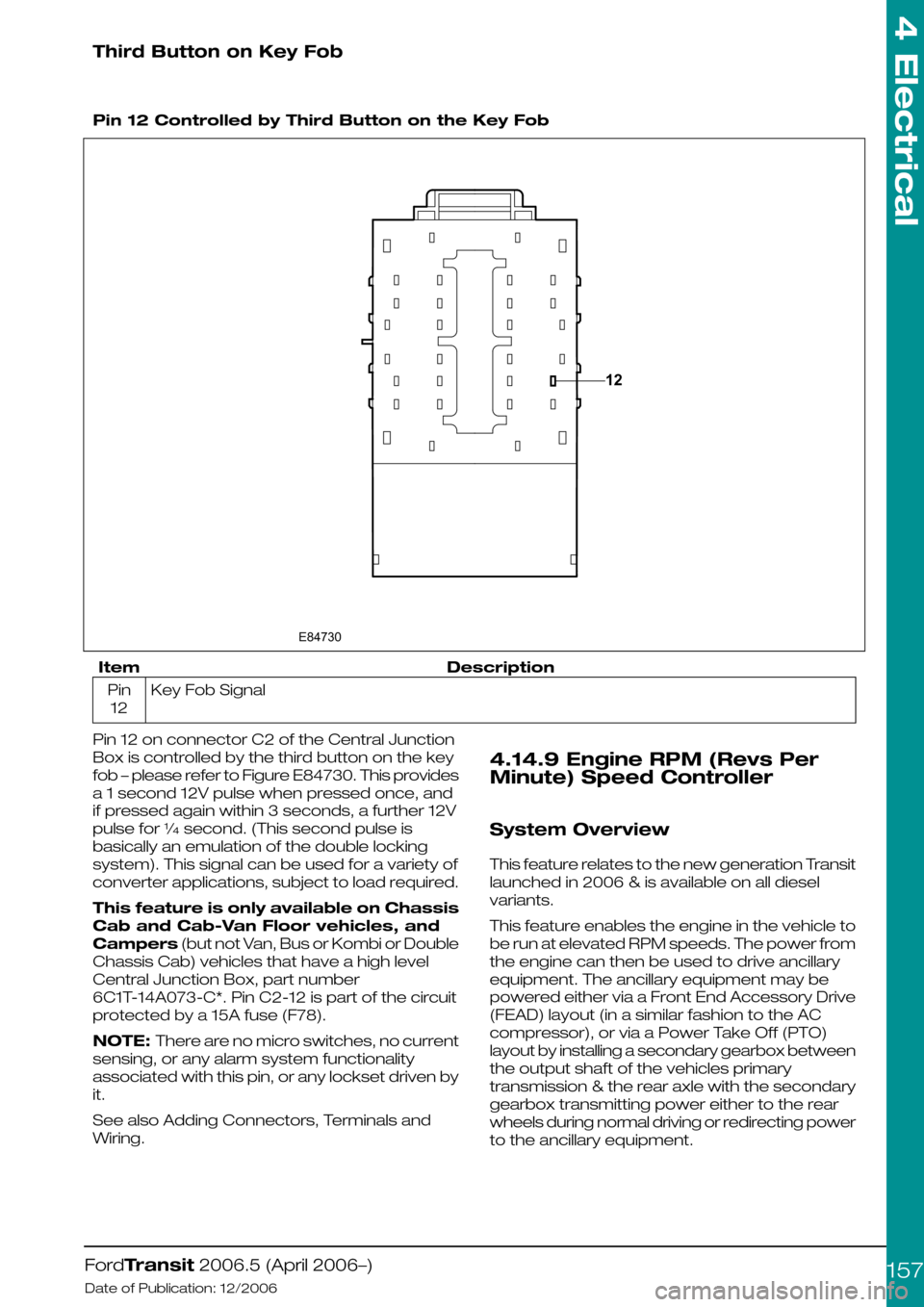
Third Button on Key Fob
Pin 12 Controlled by Third Button on the Key Fob
DescriptionItem
Key Fob SignalPin
12
Pin 12 on connector C2 of the Central Junction
Box is controlled by the third button on the key
fob – please refer to Figure E84730. This provides
a 1 second 12V pulse when pressed once, and
if pressed again within 3 seconds, a further 12V
pulse for ¼ second. (This second pulse is
basically an emulation of the double locking
system). This signal can be used for a variety of
converter applications, subject to load required.
This feature is only available on Chassis
Cab and Cab-Van Floor vehicles, and
Campers (but not Van, Bus or Kombi or Double
Chassis Cab) vehicles that have a high level
Central Junction Box, part number
6C1T-14A073-C*. Pin C2-12 is part of the circuit
protected by a 15A fuse (F78).
NOTE: There are no micro switches, no current
sensing, or any alarm system functionality
associated with this pin, or any lockset driven by
it.
See also Adding Connectors, Terminals and
Wiring.
4.14.9 Engine RPM (Revs Per
Minute) Speed Controller
System Overview
This feature relates to the new generation Transit
launched in 2006 & is available on all diesel
variants.
This feature enables the engine in the vehicle to
be run at elevated RPM speeds. The power from
the engine can then be used to drive ancillary
equipment. The ancillary equipment may be
powered either via a Front End Accessory Drive
(FEAD) layout (in a similar fashion to the AC
compressor), or via a Power Take Off (PTO)
layout by installing a secondary gearbox between
the output shaft of the vehicles primary
transmission & the rear axle with the secondary
gearbox transmitting power either to the rear
wheels during normal driving or redirecting power
to the ancillary equipment.
FordTransit 2006.5 (April 2006–)
Date of Publication: 12/2006
4 Electrical
15712E84730
Page 230 of 234
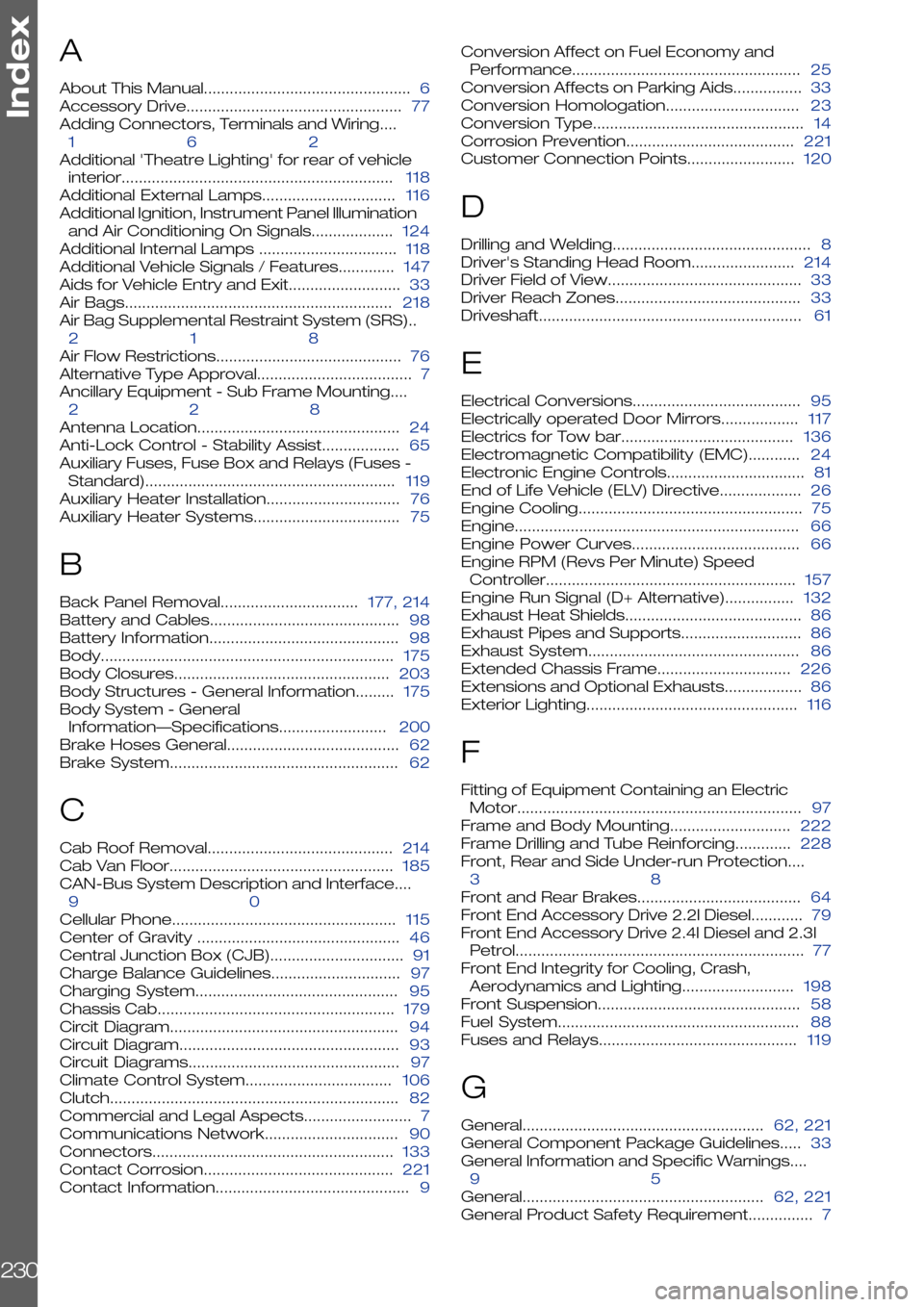
A
About This Manual................................................6
Accessory Drive..................................................77
Adding Connectors, Terminals and Wiring....
162
Additional 'Theatre Lighting' for rear of vehicle
interior...............................................................118
Additional External Lamps...............................116
Additional Ignition, Instrument Panel Illumination
and Air Conditioning On Signals...................124
Additional Internal Lamps ................................118
Additional Vehicle Signals / Features.............147
Aids for Vehicle Entry and Exit..........................33
Air Bags..............................................................218
Air Bag Supplemental Restraint System (SRS)..
218
Air Flow Restrictions...........................................76
Alternative Type Approval....................................7
Ancillary Equipment - Sub Frame Mounting....
228
Antenna Location...............................................24
Anti-Lock Control - Stability Assist..................65
Auxiliary Fuses, Fuse Box and Relays (Fuses -
Standard)..........................................................119
Auxiliary Heater Installation...............................76
Auxiliary Heater Systems..................................75
B
Back Panel Removal................................177, 214
Battery and Cables............................................98
Battery Information............................................98
Body....................................................................175
Body Closures..................................................203
Body Structures - General Information.........175
Body System - General
Information—Specifications.........................200
Brake Hoses General........................................62
Brake System.....................................................62
C
Cab Roof Removal...........................................214
Cab Van Floor....................................................185
CAN-Bus System Description and Interface....
90
Cellular Phone....................................................115
Center of Gravity ...............................................46
Central Junction Box (CJB)...............................91
Charge Balance Guidelines..............................97
Charging System...............................................95
Chassis Cab.......................................................179
Circit Diagram.....................................................94
Circuit Diagram...................................................93
Circuit Diagrams.................................................97
Climate Control System..................................106
Clutch...................................................................82
Commercial and Legal Aspects.........................7
Communications Network...............................90
Connectors........................................................133
Contact Corrosion............................................221
Contact Information.............................................9
Conversion Affect on Fuel Economy and
Performance.....................................................25
Conversion Affects on Parking Aids................33
Conversion Homologation...............................23
Conversion Type.................................................14
Corrosion Prevention.......................................221
Customer Connection Points.........................120
D
Drilling and Welding..............................................8
Driver's Standing Head Room........................214
Driver Field of View.............................................33
Driver Reach Zones...........................................33
Driveshaft.............................................................61
E
Electrical Conversions.......................................95
Electrically operated Door Mirrors..................117
Electrics for Tow bar........................................136
Electromagnetic Compatibility (EMC)............24
Electronic Engine Controls................................81
End of Life Vehicle (ELV) Directive...................26
Engine Cooling....................................................75
Engine..................................................................66
Engine Power Curves.......................................66
Engine RPM (Revs Per Minute) Speed
Controller..........................................................157
Engine Run Signal (D+ Alternative)................132
Exhaust Heat Shields.........................................86
Exhaust Pipes and Supports............................86
Exhaust System.................................................86
Extended Chassis Frame...............................226
Extensions and Optional Exhausts..................86
Exterior Lighting.................................................116
F
Fitting of Equipment Containing an Electric
Motor..................................................................97
Frame and Body Mounting............................222
Frame Drilling and Tube Reinforcing.............228
Front, Rear and Side Under-run Protection....
38
Front and Rear Brakes......................................64
Front End Accessory Drive 2.2l Diesel............79
Front End Accessory Drive 2.4l Diesel and 2.3l
Petrol...................................................................77
Front End Integrity for Cooling, Crash,
Aerodynamics and Lighting..........................198
Front Suspension...............................................58
Fuel System........................................................88
Fuses and Relays..............................................119
G
General........................................................62, 221
General Component Package Guidelines.....33
General Information and Specific Warnings....
95
General........................................................62, 221
General Product Safety Requirement...............7
Index
230
Page 231 of 234
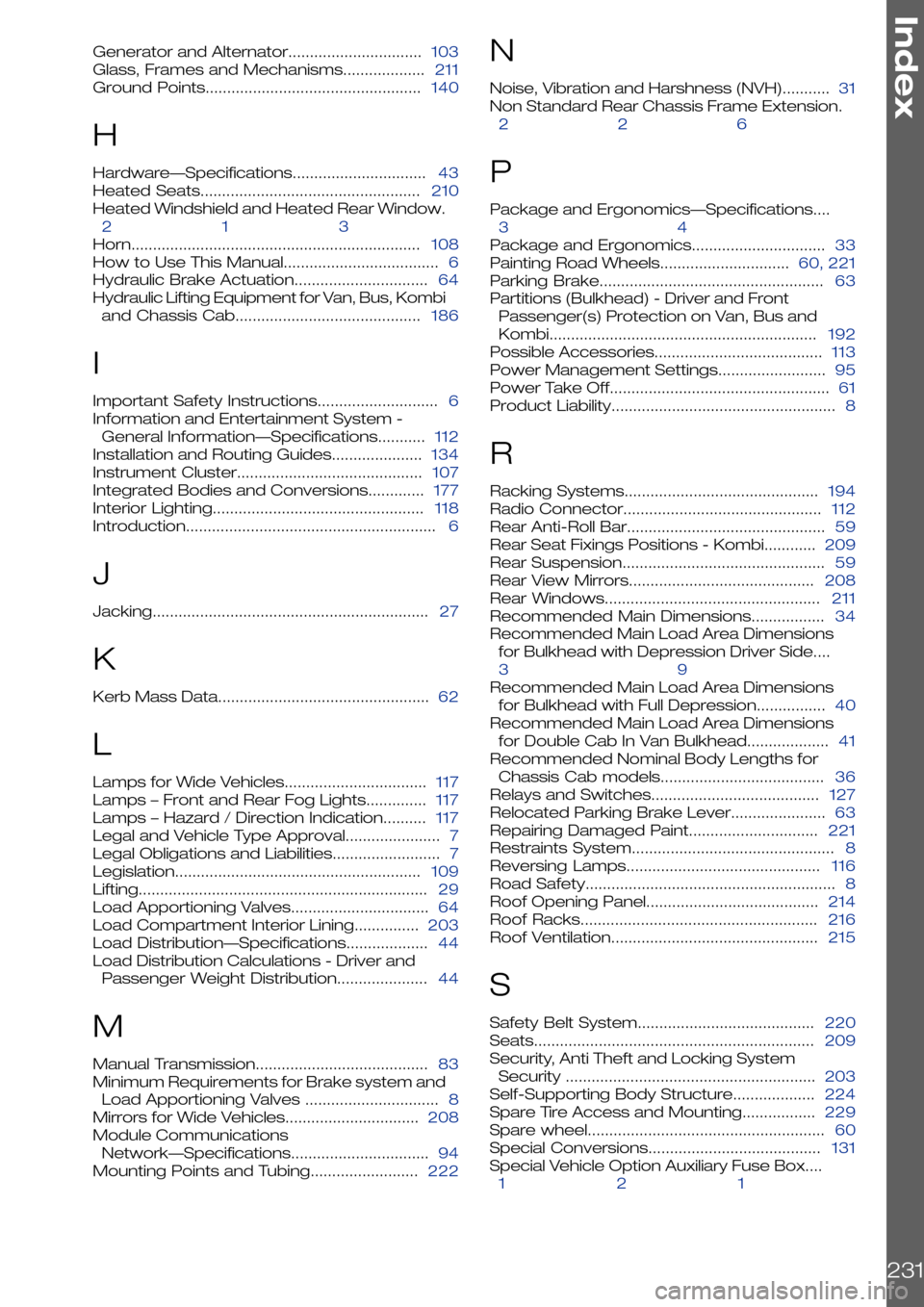
Generator and Alternator...............................103
Glass, Frames and Mechanisms...................211
Ground Points..................................................140
H
Hardware—Specifications...............................43
Heated Seats...................................................210
Heated Windshield and Heated Rear Window.
213
Horn...................................................................108
How to Use This Manual....................................6
Hydraulic Brake Actuation...............................64
Hydraulic Lifting Equipment for Van, Bus, Kombi
and Chassis Cab...........................................186
I
Important Safety Instructions............................6
Information and Entertainment System -
General Information—Specifications...........112
Installation and Routing Guides.....................134
Instrument Cluster...........................................107
Integrated Bodies and Conversions.............177
Interior Lighting.................................................118
Introduction..........................................................6
J
Jacking................................................................27
K
Kerb Mass Data.................................................62
L
Lamps for Wide Vehicles.................................117
Lamps – Front and Rear Fog Lights..............117
Lamps – Hazard / Direction Indication..........117
Legal and Vehicle Type Approval......................7
Legal Obligations and Liabilities.........................7
Legislation.........................................................109
Lifting...................................................................29
Load Apportioning Valves................................64
Load Compartment Interior Lining...............203
Load Distribution—Specifications...................44
Load Distribution Calculations - Driver and
Passenger Weight Distribution.....................44
M
Manual Transmission........................................83
Minimum Requirements for Brake system and
Load Apportioning Valves ...............................8
Mirrors for Wide Vehicles...............................208
Module Communications
Network—Specifications................................94
Mounting Points and Tubing.........................222
N
Noise, Vibration and Harshness (NVH)...........31
Non Standard Rear Chassis Frame Extension.
226
P
Package and Ergonomics—Specifications....
34
Package and Ergonomics...............................33
Painting Road Wheels..............................60, 221
Parking Brake....................................................63
Partitions (Bulkhead) - Driver and Front
Passenger(s) Protection on Van, Bus and
Kombi..............................................................192
Possible Accessories.......................................113
Power Management Settings.........................95
Power Take Off...................................................61
Product Liability....................................................8
R
Racking Systems.............................................194
Radio Connector..............................................112
Rear Anti-Roll Bar..............................................59
Rear Seat Fixings Positions - Kombi............209
Rear Suspension...............................................59
Rear View Mirrors...........................................208
Rear Windows..................................................211
Recommended Main Dimensions.................34
Recommended Main Load Area Dimensions
for Bulkhead with Depression Driver Side....
39
Recommended Main Load Area Dimensions
for Bulkhead with Full Depression................40
Recommended Main Load Area Dimensions
for Double Cab In Van Bulkhead...................41
Recommended Nominal Body Lengths for
Chassis Cab models......................................36
Relays and Switches.......................................127
Relocated Parking Brake Lever......................63
Repairing Damaged Paint..............................221
Restraints System...............................................8
Reversing Lamps.............................................116
Road Safety..........................................................8
Roof Opening Panel........................................214
Roof Racks.......................................................216
Roof Ventilation................................................215
S
Safety Belt System.........................................220
Seats.................................................................209
Security, Anti Theft and Locking System
Security ..........................................................203
Self-Supporting Body Structure...................224
Spare Tire Access and Mounting.................229
Spare wheel.......................................................60
Special Conversions........................................131
Special Vehicle Option Auxiliary Fuse Box....
121
Index
231